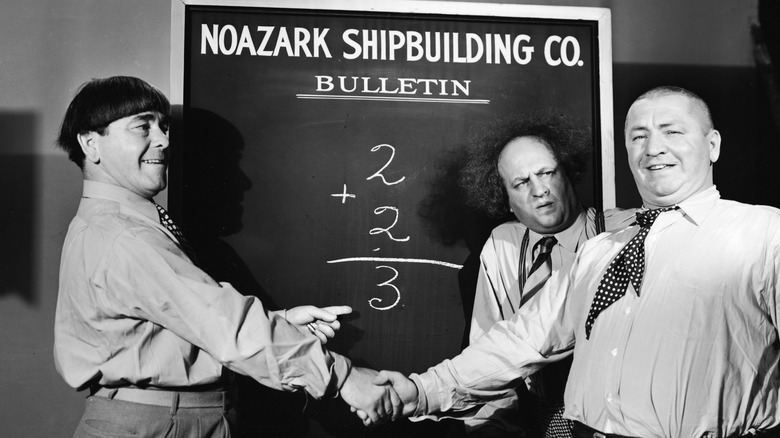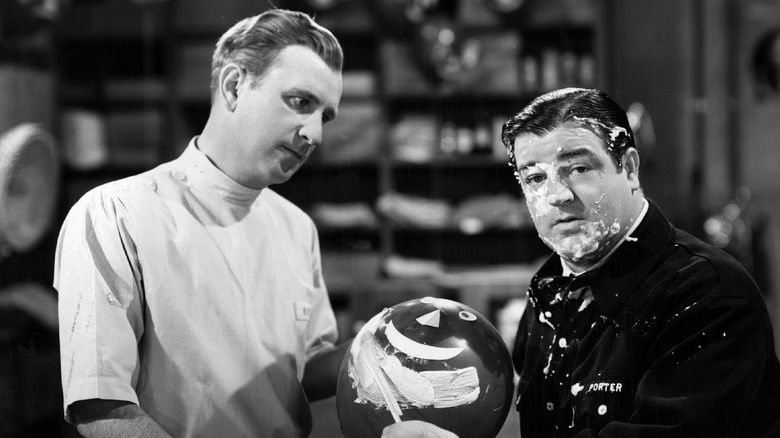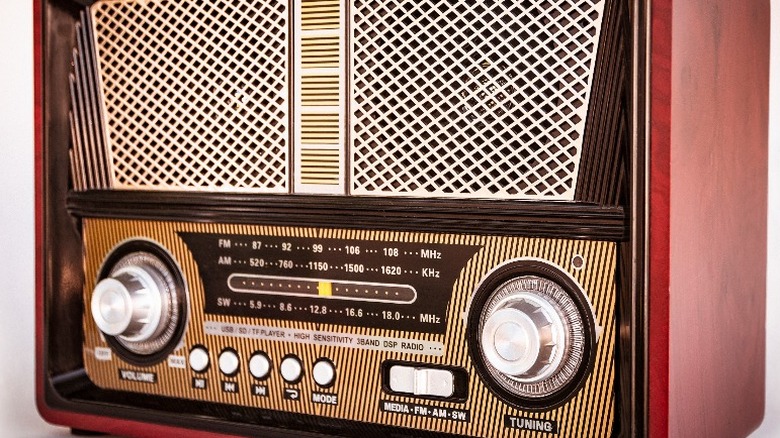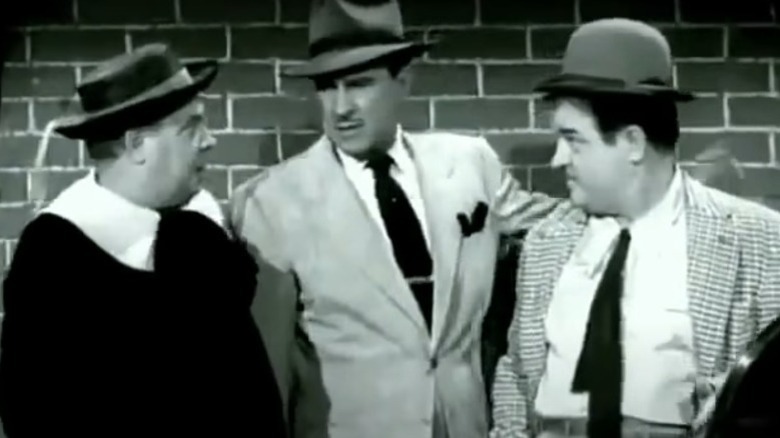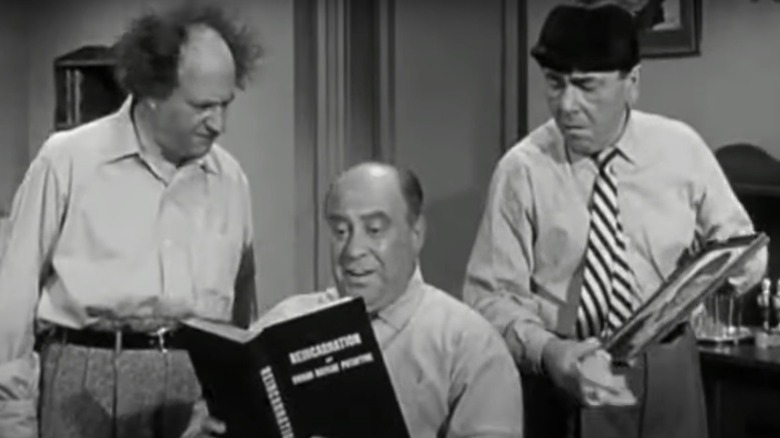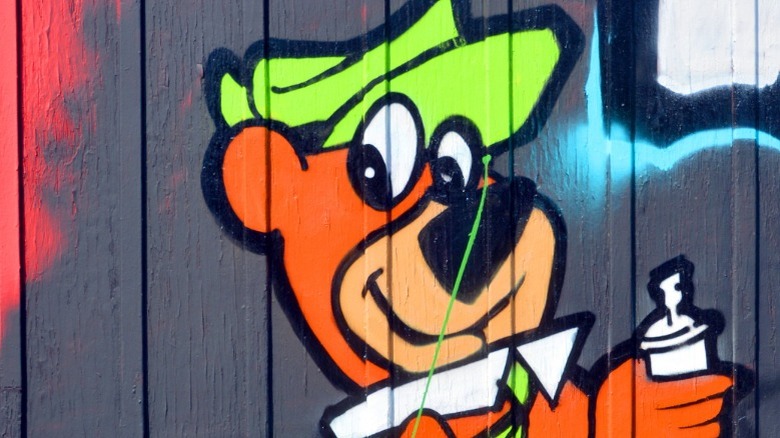The Three Stooges Star That's More Recognizable As A Part Of Another Legendary Comic Team
The trio known as "The Three Stooges" began their long career as a comedy act that toured the vaudeville circuit. Under the name "Ted Healy and His Stooges" and "Ted Healy and His Southern Gentlemen," frontman Moses Horowitz (aka Moe Howard), his brother Samuel (aka Shemp), and violinist-turned-comedian Louis Feinberg (aka Larry Fine) left audiences in stitches as they toured the United States. The gents appeared in only one feature film with Healy, 1930's "Soup to Nuts," in which they play inept firemen (per IMDb).
Shemp Howard left the act shortly afterward to pursue his own career, appearing in nearly 80 shorts and feature films (via IMDb). He was replaced by the younger Horowitz brother, Jerome, who took the stage name Curly. The Stooges soon departed from Healy and went their way, signing a deal with Columbia Pictures. Between 1930 and 1970, "The Three Stooges" would appear in over 150 film shorts, in feature films, and make cameo appearances in others. Though they only had three players at any given time, there were a total of six performers billed as one of the Stooges at one point or another, as health issues and death made replacements necessary.
Until 1946, the lineup consisted of Moe, Larry, and Curly. After Curly suffered a stroke, he was replaced by Shemp, who made a triumphant return. Shemp remained a part of the group until his death in late 1955. The man who would replace Shemp as a Stooge was no stranger to comedy, and was once an integral part of a television show starring a popular comedy duo.
The Abbott and Costello Show had an actor in common with The Three Stooges
As television began to increase in popularity, movie houses all over the country were beginning to see substantial decreases in revenue. The shorts that were in such demand from the 1930s through the early 1950s were beginning to wane, prompting many studios to cut out their shorts divisions entirely. This prompted the end of many careers that were never allowed to leap to the smaller screen. Additionally, the growing number of Americans with televisions in their homes quickly put an end to radio serials. Though some of the stars of that era went on to capitalize on the newly popular medium of TV, many found this to be a career-ender.
The comedy duo of Bud Abbott and Lou Costello (above) began on radio in the mid-1930s and leaped to feature films in 1940 (per IMDb). Popular on the big screen and over the airwaves, Abbott and Costello decided to take a stab at their television program, hoping to capitalize on TV's new popularity.
"The Abbott and Costello Show" ran two seasons, beginning in 1952. Throughout the 52 episodes that were aired, the show featured hilarious appearances by many comic actors of the era, including Bobby Barber and Gordon Jones. One actor appeared on multiple episodes of "The Abbott and Costello Show" who would later replace Shemp Howard in "The Three Stooges." The plump, balding comedic actor with the distinctively annoying voice was Joe Besser, who would come to be known as "The Fifth Stooge" (per Vulture).
Besser worked with Abbott and Costello in radio
Besser had been working in Hollywood since 1938 when he made his first short film appearance in "Cuckoorancho" (per IMDb). Throughout the 1940s, Besser appeared in multiple shorts and feature films, mostly in supporting roles and as minor characters. He had been making his mark on radio as well, with one show in particular that would help vault him to fame.
As a regular on Abbott and Costello's radio show, Besser would sub in for Costello and make appearances as other characters (via Great Entertainers Archives). When the show ended in 1949, the popular comedy duo didn't forget Besser's talents. When the TV version of "The Abbott and Costello Show" went into production in 1952, Besser was cast in a role that would eclipse any other part he would ever play.
In the show, Abbott and Costello played two unemployed men who lived in a boarding house. Besser played a regular part as Oswald "Stinky" Davis, a loud, annoying eight-year-old boy. Clad in an oversized Little Lord Fauntleroy outfit, Stinky would stalk and pester the boys, and was often seen carrying an oversized lollipop. Despite his youth, Stinky would often be able to dupe Lou, sometimes putting Lou in the way of great physical danger. Whether it was using a ruse to get Lou to stand in front of a moving car or tricking him into barreling headlong into a uniformed policeman, Stinky stole every scene with a level of cruelty that could hardly be imagined as an adult's demeanor, let alone that of an oversized child.
Stinky Davis stole every scene on The Abbott and Costello Show
Nearly every scene involving Besser as Stinky includes Lou suffering extreme physical abuse at the hands of the man-child. Stinky chomps his teeth down on Lou's hand, pinches and twists his skin, and stomps on his feet. These violent displays are paired with the various times Stinky slaps, kicks, and punches the poor man.
As Stinky, Besser stole every scene he was in, not an easy feat considering he was sharing the screen with two comedy legends. But Besser's loud and effeminate voice coupled with his physical comedy would give comedic performers from any era a run for their money. The show as a whole had an impact on comedy great Jerry Seinfeld, who, in a 1994 TV special, credits "The Abbott and Costello Show" as the major influence on him professionally. Seinfeld mentions the character Stinky throughout the special, noting how the absurdity of a balding middle-aged man playing a child can work so well with audiences (per Larry Charles Projects on YouTube). Had there not been this show and its zany characters, it's possible that there never would have been a "Seinfeld" sitcom.
After the end of "The Abbott and Costello Show," Besser continued to work steadily. His performances included some films but were mostly comprised of comedic film shorts. As the era of shorts was coming to a close, Besser stood out as one of the performers and was working with someone integral to the Stooges' universe.
Besser becomes the fifth Stooge after the death of Shemp
With over 300 credits as both a director and a producer, Jules White was a legend of the film short industry. A staple at Columbia Pictures, he produced most of the shorts involving the Stooges and had worked in that role with Besser on several post-Abbott and Costello projects.
After Shemp Howard died in November 1955, Besser was tapped to replace the beloved Stooge. The writing was on the wall for comedic shorts, however, and Besser was only able to appear in 16 Stooges episodes before Columbia Pictures ended their shorts division. The films he appeared in with Moe and Larry are often considered the worst of the Stooges shows, as the comedic styling of Besser just wasn't a great fit. The fact that Besser was immediately preceded by Shemp made his appeal to audiences that much more difficult. "The Fifth Stooge" is often seen as a flop, blamed for the end of the Stooges' long run in the business of comedic shorts. While that is an unfair assessment, it's the truth that audiences did not particularly care for Besser in this role. The sub-par scripts certainly didn't help (via Vulture).
When Columbia Pictures ended the Stooges' contract, Besser left the business for a time to care for his wife who had become seriously ill. When she recovered, Besser resumed his career. Having been replaced by the sixth and final Stooge, Joe DeRita, for a successful run of "Three Stooges" feature films, Besser took his talents in another direction.
Besser was an accomplished voice actor
Besser appeared as a regular on "The Joey Bishop Show," bringing his talents to nearly 100 episodes of that situation comedy (per IMDb). He made regular appearances on other popular 1960s sitcoms as well, cast in roles for "The Mothers-In-Law" and "Batman." But it was his voice that led him to the next phase in his career, lasting until he retired in 1986.
Besser began getting steady work as a voice actor, his whiny cadence being a staple for multiple Saturday morning cartoons. His work on Abbott and Costello's radio and television shows opened doors for Besser later in his career (via IMDb). His voice was the center of 1970s cartoons "The Houndcats," "The New Scooby-Doo Movies," and "Jeannie." He worked for the Hannah-Barbera studio in multiple animated shows, captivating youth audiences with his character Scare Bear, which was a character in "Galaxy Goof-Ups," and "Yogi's Space Race." In the '80s, he was one of the main voice actors for the "Shirt Tails" cartoon, before appearing in his final cartoon in 1986 as the voice of Cupid in an episode of "The Smurfs."
While Besser might not be known to audiences under 40, many Gen X and Boomers are familiar with the actor, if not from his hilarious antics on "The Abbott and Costello Show" and his role as the Fifth Stooge, then as the familiar voice of cartoon characters that provided part of the soundtrack to Saturday mornings of yesteryear.
